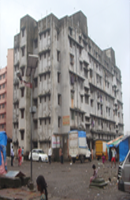| |
| Slum Redevelopment |
| |
| Projects in a nutshell |
| |
| |
 |
|
| Watch the Demolition to Development story on Youtube |
|
|
| MILAN NAGAR, MUMBAI, 1999 |
| |
Milan Nagar is one of the Alliance’s most important projects because it is for the rehabilitation of the Byculla pavement dwellers – the community with which SPARC began its work in 1984 in central Mumbai. The Alliance spent nearly a decade negotiating with the municipal authorities over the right of pavement dwellers to be resettled. During the same time, Byculla Mahila Milan organized savings groups and initiated a search for vacant land on which to build rehabilitation housing. It is also the project from which the alliance began to associate with Homeless International.
In 1996, the SRA policy was finally amended to include pavement dwellers within the resettlement entitlement lists. In 1998, State authorities allocated land in Mankhurd for the Byculla pavement dwellers to develop resettlement and rehabilitation housing. The land (4700 sq.mt) was part of a separate SRA project constructed by the Maharashtra Housing and Area Development Authority (MHADA), and a portion was granted for Milan Nagar, as the project also constituted rehabilitation housing.
Significant time and money went into designing the unique, split-level units, so that the “one room” R&R entitlement could become 2-3 separate spaces for better privacy and division of space. CLIFF provided the project loans. There is no sales component, since the space constraints of the site require that all units go toward the rehabilitation
of pavement dwellers.
One of the four buildings has been constructed at Milan Nagar, and 83 families were resettled there in 2005. The construction of the three remaining buildings was delayed as households affected by the construction of Mankhurd Station were allotted temporary space on the Milan Nagar plot in 2003. In 2012, these households were finally allotted getting rehabilitation housing elsewhere so the remaining three buildings can now be constructed. As with other redevelopment projects, a joint venture with a developer will be used to complete the outstanding buildings. |
|
| |
|
|
| |
|
|
|
| |
|
| |
| |
|
 |
 |
 |
 |
 |
| |
|
|
|
| MILAN NAGAR, MUMBAI, 1999 |
RAJIV INDIRA,
MUMBAI, 2002 |
BHARAT JANTA, MUMBAI, 2002 |
OSHIWARA-2,
MUMBAI, 2009 |
| |
|
|
|
 |
 |
|
|
| |
|
|
|
| KANJURMARG-3, MUMBAI, 2010 |
MILAN NAGAR Phase 2, MUMBAI, 2013-ongoing |
|
|
| |
|
|
|
|
|
| |
|
| |
| Policy + Impact |
| |
In India, FSI (Floor Space Index) to cross subsidize construction by developers is being undertaken in Bombay, Pune and Nagpur in Maharashtra where a 1995 state policy for this purpose was enacted. Under the Slum rehabilitation scheme, NGOs, an additional incentive to build rehabilitation housing in exchange for on site floor space index increases in form of sale units and transferable FSI increases in the form of TDR. Households do not make a financial contribution but their agreement to allow their present dwellings to be torn down is seen as their contribution in lieu of their investments of the past. Earnings from TDR and the sale of market-rate housing are used to pay for construction costs; but a more important contribution of SRA is to provide security of tenure for slum dwellers.
The Alliance has taken up these projects with the following intentions:
|
01 To demonstrate that NGOs can design solutions where housing is built for communities and not market interests
02 To develop dialogue and negotiations with financial institutions to blend funds
03 To capacitate community cooperatives to manage housing after construction
04 To develop recommendations for government to improve and refine the policy to reach out to more households and settlements.
05 To explore ways to adapt and change some aspects to make this strategy work in other cities and other countries. |
| |
| |
| |
| |
| |
| |
| |
| |
| |
| |
| |
| |
| |
| |
| |
| |
| |
| |
| |
| |
| |
| |
| |
| |
| |
| |
| |
|
|